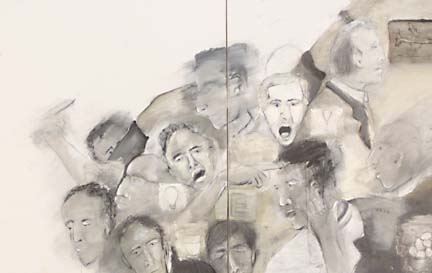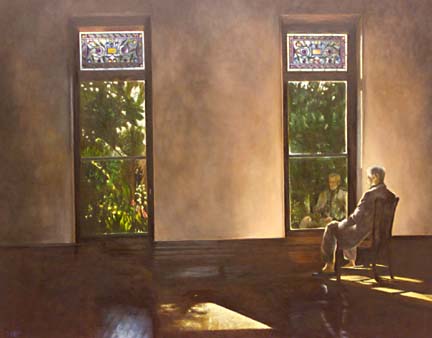
KEN IGE / KIGE@STARBULLETIN.COM
"Tiger in Mangoes" is an oil on canvas by Elizabeth Slick.
Art academy's ex-director changes
the essence of the annual juried show
LIKE EVERYONE else in the arts community, George Ellis challenged the relevance of the Honolulu Academy of Arts' annual "Artists of Hawaii" juried show. He seriously considered changing and possibly ending it after he took the helm as director and president of the academy in 1982.
'Artists of Hawaii 2003'
On view: Opens Thursday, running 10 a.m. to 4:30 p.m. Tuesdays to Saturdays and 1 to 5 p.m. Sundays through July 27Place: Honolulu Academy of Arts
Admission: $7 general; $4 seniors, students and military; under 12 free
Call: 532-8700
Ellis said his first encounter with the show, in the late '70s, had left him unimpressed. "But in due course, I came to understand the merit of the show," he said.
"'Artists of Hawaii' serves as a springboard for emerging artists. If a work shows promise, originality, a spark of creativity, it should be shown."
In its 53 years of existence, the all-media exhibition, the oldest and largest juried show in Hawaii, has never failed to spark lively debate. Over the years, a common criticism in the community has been the academy's use of an outside juror -- a nonresident of Hawaii -- to judge the works. While outside jurors come equipped with a fresh eye for Hawaii talent, they often tend to pick the same kinds of work each year that, art aficionados complain, may be new to the juror but are passé for a local art audience that follows the show from year to year. Other complaints have been that the show has been "too exclusive," "too inclusive," "too crafty," "too trite."
Ellis, who retired in February, breaks the trend this year as the first local juror of the show in decades, and as such will perhaps placate its critics. But whoever the juror may be, "the quality of the show is always determined by what is submitted," Ellis said last month at a public talk about this year's exhibit. "That's the major distinction between juried shows of this kind and those with invited artists. If you want only the very best of what's offered, 'Artists of Hawaii' is not the show to provide that."
KEN IGE / KIGE@STARBULLETIN.COM
Renee Iijima's "A Dream of Karma," is a mixed-media work in Xerox, wax, ink, color pencil, in an antique frame.
Yet there was no shortage of talent in the pool of work submitted this year. Ellis waded through nearly 1,000 pieces from about 400 local artists and pared the submissions down to 167 during his first jurying session. It was during this stage of the process that Ellis spoke about his experience as juror.
KEN IGE / KIGE@STARBULLETIN.COM
"Self Portrait," an oil on canvas, is by Cory Morgenstein.
"I've selected only one work from each artist, and I'm down to 165 works and they're all great. I've rejected stuff I didn't want to leave out, but the room will only hold a maximum of 125 pieces. I will be taking out some very good works," he lamented.
"George tried to be as inclusive as possible," said Jennifer Saville, the academy's curator of Western art and project director for "Artists of Hawaii 2003." "He decided to include only one work by each artist to show as many artists as possible. He strove for balance of media and was concerned about including artwork of different styles."
KEN IGE / KIGE@STARBULLETIN.COM
"Fish Camera: Pinhole Papio" is a pinhole camera made of pine, balsa, Styrofoam and felt, by Scott Terufumi Kubo.
Ellis' inclusive jurying style contrasts dramatically with that of past jurors. In the 1970s, he said, jurors were extremely exclusive. "In 1972 there were 37 works shown by 33 artists. In 1973, 26 artists and 28 works. In 1977, 23 works by 18 artists. In 1978, there were 17 works by 15 artists!
"This didn't speak very well for the situation. It just spoke to the arrogance of the juror. How horrible for someone to come into the state and say there are only 17 artists worth showing."
The 1980s welcomed art teachers as jurors, which opened up the show to a greater spectrum of artists, Ellis said. In 1986 there were 124 works by 105 artists; in 1989, 83 works by 66 artists.
KEN IGE / KIGE@STARBULLETIN.COM
"Egg Dreams" is an oil on canvas by Lynda Hess.
The final count for this show is 91 works by 91 artists. A concurrent exhibition will feature works by Allyn Bromley, Laura Ruby, Laura Smith and Dodie Warren.
"Teachers are charged with opening visions rather than closing them," he said, which led to more diverse shows.
Saville says that some jurors prefer to show more works by fewer artists, which allows the exhibit to display the range of the artists.
KEN IGE / KIGE@STARBULLETIN.COM
"Traders" is a two-panel sketch in graphite, crayon, gel, gesso and oxides on canvas by Jodi Endicott.
But no matter what approach a juror takes, Ellis believes any juror "should be unbiased in deeming the quality of individual styles, despite personal preferences." And no matter how inclusive a juror wishes to be, Ellis thinks that endeavor "should be tempered by the concept of excellence. A juror must never pander to bad work."
As always, viewers will be there on Thursday with their criticisms ready. But that is part of the artistic process, the encouragement of thought and debate, and Ellis doesn't have a problem with that.
KEN IGE / KIGE@STARBULLETIN.COM
"The Long Good-bye" is an oil on canvas by Madeleine McKay.
Click for online
calendars and events.








